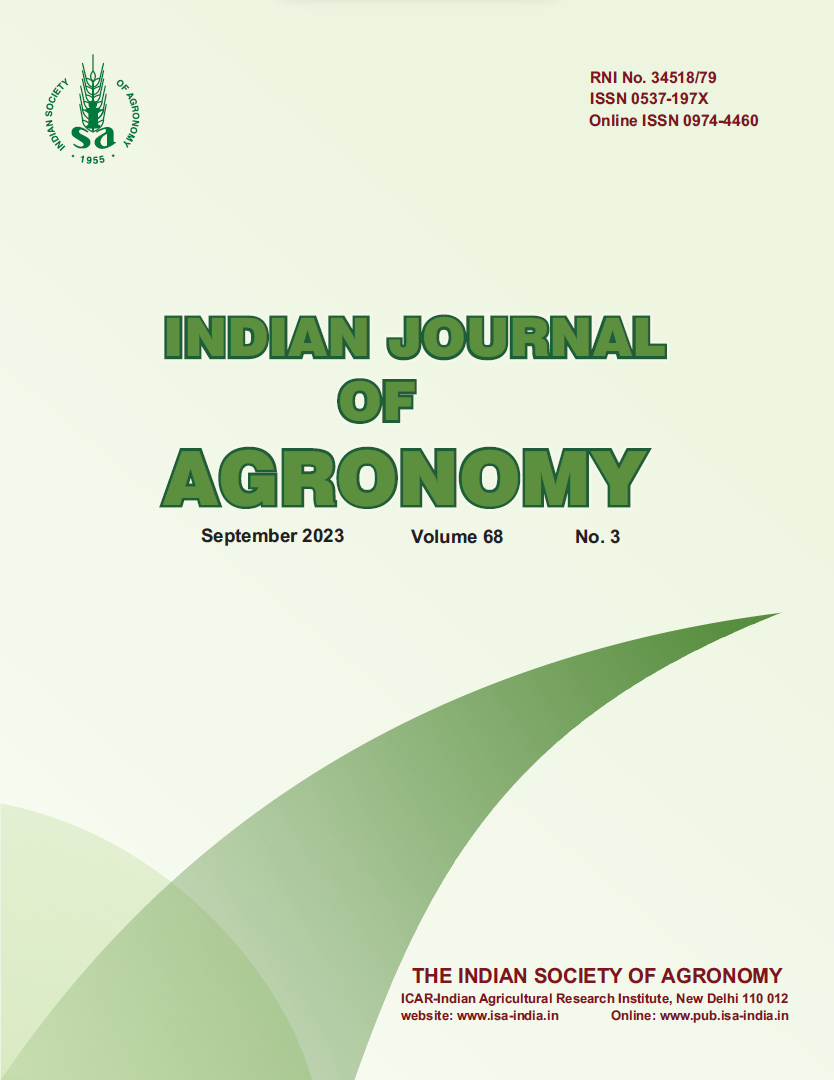Effect of land configuration, irrigation regimes and nitrogen application on growth, yield and quality of Japanese mint (Mentha arvensis)
DOI:
https://doi.org/10.59797/ija.v68i3.2821Keywords:
Irrigation, Land configuration, Mentha, Nitrogen, YieldAbstract
An experiment was conducted during summer season of 2016–17 at the Narendra Deva University of Agriculture and Technology, Faizabad, Uttar Pradesh, to study the effect of land configuration, irrigation regimes and nitrogen application on growth, yield and quality of Japanese mint (Mentha arvensis). The treatments consisted of 3 land configurations (flat-bed planting, ridge planting and raised-bed planting), 3 irrigation regimes 0.8 irrigation water: cumulative pan evaporation (IW: CPE), 1.0 IW: CPE and 1.2 IW: CPE ratio) and 3 nitrogen levels recommended dose of nitrogen [(RDN) 160 kg N/ha], 75% RDN (120 kg N/ha) and 125% RDN (200 kg N/ha)] in a splitplot design with 3 replications. Raised-bed planting recorded the maximum leaves/plant (188.8), plant fresh weight (1868 g/m2 ), leaf: stem ratio (1.84), herbage (1.80 t/ha) and oil yield (136.5 lit./ha) than the ridge and flat-bed planting. Irrigating the crop at an IW: CPE ratio of 1.2 resulted in the highest growth parameters, herb (1.71 t/ha) and oil yield (130.1 lit./ha) and quality parameters over other irrigation regimes. Significantly the maximum crop growth [leaves/plant (189.8), plant fresh weight (1784 g/m2), leaf: stem ratio (1.77)], herbage (1.71 t/ha) and oil yield (131.9 lit./ha); and quality parameters [carotenoid content (2.66 mg/g fresh weight), menthone content (6.23%), menthol content (72.0%) and oil content (0.77%)] were recorded with the application of 125% RDN over 75% RDN and it was at par with 100% RDN. This study indicated that planting on raised bed, irrigation at 1.2 IW: CPE ratio and the application of 125% RDN (200 kg N/ha) gave higher yield and quality of Japanese mint.
References
Behera, M.S., Mahapatra, P.K., Singandhupe, R.B. and Kanan, K. 2015. Fertigation studies in Japanese mint (Mentha arvensis) under humid climate in Odisha, India. African Journal of Agricultural Research 10(11): 1,320–1,330.
Behera, M.S., Verma, O.P., Mahapatra, P.K., Singandhupe, R.B. and Kumar, A. 2013. Effect of irrigation and fertility levels on yield, quality and economics of Japanese mint (Mentha arvensis) under drip irrigation system. Indian Journal of Agronomy 58(1): 109–113.
Choudhary, H., Badal, P.S., Singh, V. and Maurya, A. 2018. Accessing the socio-economic grade of menthol growers in India: Shifting from traditional farming to income-based farming. Medicinal Plants 10(4): 340–347.
Izhar, M., Khan, M., Yasmin, D.T. and Zahid, N.Y. 2015. Differential effect of fertilizers on menthol contents in mint (Mentha arvensis). American Research Journal of Agriculture 1(1): 55–60.
Kaur, T., Singh, S., Bhullar, M., Shergill, L.S. and Kaur, R. 2013. Effect of planting methods and weed control on productivity of Japanese mint (Mentha arvensis). Indian Journal of Agricultural Research 47(3): 243–247.
Lakra, K. and Verma, S.K. 2021. Water economization in Japanese mint through crop establishment, irrigation and nitrogen levels. Indian Journal of Agricultural Sciences 91(5): 792–795.
Lichtenthaler, H.K. and Buschmann, C. 2001. Chlorophylls and carotenoids: measurements and characterization by UV–VIS spectroscopy. In Book: Current Protocols in Food Analytical Chemistry (Supplement 1), F4.3.1-F 4.3.8. John Wiley, New York.
Mahantesh, P.S., Gangadharappa, P.M., Eragegowda, M., Ravi, M.D., Hussain, S. and Bhat, D.S. 2017. Influence of row spacing and nitrogen levels on biochemical and quality parameters of Japanese mint. International Journal of Current Microbiology and Applied Sciences 6(12): 2,086–2,092.
Singh, A., Singh, K.B. and Singh, G. 2018a. Water balance and water productivity of Japanese mint (Mentha arvensis) as affected by irrigation and mulching. Indian Journal of Agronomy 63(1): 105–109.
Singh, G., Saha, T., Chandra, S., Bhatnagar, A. and Samarth. 2018. Productivity of menthol mint (Mentha arvensis) and wheat (Triticum aestivum) as relay and sequential cropping system under different irrigation scheduling. Indian Journal of Agronomy 63(1): 110–116.
Singh, K.B., Jalota, S.K. and Gupta, R.K. 2015. Soil water balance and response of spring maize (Zea mays) to mulching and differential irrigation in Punjab. Indian Journal of Agronomy 60(2): 279–284.
Zheljazkov, V.D., Cantrell, C.L. and Astatkie, T. 2010. Study on Japanese cornmint in Mississippi. Agronomy Journal 102: 696–702.






